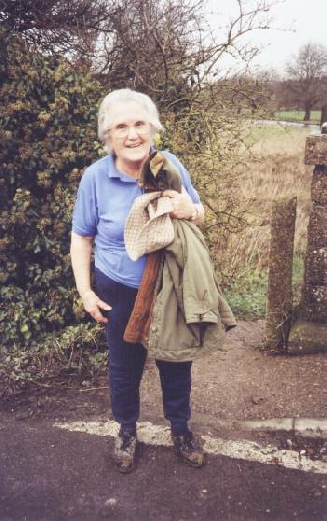



The Parish Church of St George the Martyr, Waterlooville

Family finances dictated a return to work and by the late 1960s she had returned to a full time position, this time working as a clerical officer at the local hospital. Rapid promotion ensued and by 1978 she had managed to secure a job as the District Medical Records Officer – a title not used today but a senior NHS administration post in the day. That post necessitated a move to the east end of London and Slough was finally left, but not before all four children had already left home to follow their own paths.
The move to Waterlooville took place in September 1985 after both she and George had retired. They looked at various churches before settling on St George’s. George grew up in the Roman Catholic Church and Winifred in the evangelical end of the Anglican Church but St George’s met both their needs and they enjoyed being regular communicants within the congregation there. Winifred went on to not only serve in the choir but to become a Churchwarden and actively involved in the Mothers’ Union.
Despite having left school age 14 she was far from being poorly educated; she loved learning and was always on the hunt for new knowledge. When her husband George died in March 1998 the University of Portsmouth were creating a new degree programme – Church and Community Studies – which could be studied at both Bachelor and Master’s level. She decided that it was time for a challenge and so, also needing to ease her grief, she decided to enrol on the Master’s programme. Not the easy option for someone in her seventies with little formal education. She persuaded her daughter to join her on the course – it also solved the transport problem – and the following two academic years were spent attending lectures as a part time student. She revelled in the challenge, which also included having to learn how to work a word processor. That proved almost more challenging than the course as, despite being a touch typist, she found a computer keyboard hard to master: ‘it just isn’t the same’ was her constant lament. Having successfully achieved a good pass in all the taught modules she decided that tackling the dissertation was going to take more effort than she was willing to give. She had proved to herself that she was academically capable. What more did she need to do? Thus she exited the programme with a Post Graduate Diploma: not bad for a now 77 year old. Her love of learning had served her well and she passed that onto her children always encouraging them to be independent thinkers and doers.
The family was continuing to grow; the four children had morphed into nine grandchildren and four step grandchildren and by 1997 the first great grandchild had been born. They were proud of their family and Winifred and George were never happier than when the family were around them. By July 2014 the number of great grandchildren had risen to seventeen and she continued to receive regular visits from many of them up until the day before she died.
A strong and independent lady her real legacy is in the strong family ties that she fostered in all of the family. She will be greatly missed, both as an ear to listen to all the woes that anyone wanted to share with her but also as the fountain of wise advice.
Autumn Edition 2014
Winifred Grace Mancz, 1923-2014

Winifred was born in Slough the third of five children: four girls and a boy. The day after her third birthday her brother Ernest was born – and she was convinced as only a small child can be that he was a late birthday present!
She grew up as a member of St Paul’s Church in Slough – a building that her uncle had helped to construct at the beginning of the Edwardian era – and she became actively involved in the Young People’s Fellowship (YPF) and Campaigners both as a member and as a leader. She had to leave school at the age of 14 because there weren’t the family finances to support her in any further education – it had to be targeted to her only brother. It proved to be a challenge that she rose to all her life. If you want it enough you will go after it. She worked for ICI Paints Division as a secretary, rising to become a PA.
Towards the end of her twenties and still living at home she decided that the time had come to move on so she took a job within ICI but based in Manchester. On her arrival her new boss asked her whether she was going to rapidly leave to get married. Having assured him that she knew no-
Four children rapidly followed – Maria in October 1954, Nicolas in January 1956, George in October 1957 and Paul in August 1960. A move back to Slough in 1958 resulted in the four children all growing up in St Paul’s as their mother had done; the boys being choristers from a young age and Maria joining the choir age 13 when girls were finally allowed to join due to the failure to recruit and retain enough boys. Winifred joined later once women were also able to join and she continued to sing in a church choir until well into her eighties when the stairs to the choir stalls at St George’s proved too much for her.
Winifred photographed on a Parish Ramble (1999)